Psychology, 2017, 8, 1919-1940
http://www.scirp.org/journal/psych
ISSN Online: 2152-7199
ISSN Print: 2152-7180
Stress and Well-Being of University Staff: An
Investigation Using the Demands-Resources-
Individual Effects (DRIVE) Model and
Well-Being Process Questionnaire (WPQ)
Gary Williams, Kai Thomas, Andrew P. Smith*
Centre for Occupational and Health Psychology, School of Psychology, Cardiff University, Cardiff, UK
How to cite this paper: Williams, G.,
Thomas, K., & Smith, A. P. (2017). Stress
and Well-Being of University Staff: An
Investigation Using
the Demands-Re-
sources-Individual Effects (DRIVE) Model
and Well-Being Process Questionnaire
(WPQ). Psychology, 8, 1919-1940.
https://doi.org/10.4236/psych.2017.812124
Received: August 23, 2017
Accepted: October 13, 2017
Published: October 16, 2017
Copyright © 2017 by authors and
Scientific Research Publishing Inc.
This work is licensed under the Creative
Commons Attribution International
License (CC BY 4.0).
http://creativecommons.org/licenses/by/4.0/
Open Access
Abstract
Research suggests that university staff have high stress levels but less is known
about the well-being of this group. The present study used an adapted version
of the Demands-Resources-Individual Effects (DRIVE) model to investigate
these topics. It also used the Well-Being Process Questionnaire (WPQ) which
consists of single items derived from longer scales. One hundred and twenty
university staff participated in an online survey. The single items had good
concurrent validity and estimated reliability. Factor analyses showed that sin-
gle items and the longer scales loaded on the same factor. Work characteristics
could be sub-divided into two factors (resources and demands), as could per-
sonality (positive personality and openness/agreeable/conscientious), coping
(positive and negative coping) and outcomes (positive well-being and negative
outcomes such as stress and anxiety). Results from regressions showed that
positive well-being was predicted by positive personality and positive coping.
Negative outcomes were predicted by job demands and negative coping.
Overall, the study has demonstrated the utility of the adapted DRIVE model
and shown that a short single item measuring instrument can quickly capture
a wide range of job and psychosocial characteristics.
Keywords
DRIVE Model, WPQ, Wellbeing, University Staff
1. Introduction
The aim of the present study was to investigate stress and well-being in univer-
sity staff using the Demands-Resources-Individual Effects (DRIVE) model
1919
Psychology
DOI: 10.4236/psych.2017.812124 Oct. 16, 2017
�
G. Williams et al.
DOI: 10.4236/psych.2017.812124
(Mark & Smith, 2008) and a measuring instrument using short versions of estab-
lished questionnaires (the Wellbeing Process Questionnaire—WPQ Short Form,
Williams & Smith, 2012). The DRIVE model considers both work characteristics
and individual effects. It has largely been used to study negative outcomes but is
adapted here to also investigate positive wellbeing. As more variables are in-
cluded in a survey the length of it increases and this leads to reduced compliance
from participants. The WPQ consists of single items measuring the same con-
cepts as longer scales. Previous research has established the validity of this ap-
proach which is here applied to investigate the wellbeing of university staff. The
next section briefly reviews stress and well-being of university staff.
1.1. Stress and Well-Being of University Staff
Research (e.g. Winefield & Jarrett, 2001; Kinman, 2001; 2008) suggests that stress
levels in academic institutions are high and that stress has increased significantly
over the last 20 years. This may reflect the persistent demands of academic life
(Singh & Bush, 1998) and the large number of competing roles, such as teaching,
research, seeking funding, writing papers, and meeting seminar and tutorial
commitments (Abouserie, 1996). The stress may also be attributed to falling salaries
and increasing workloads (Fisher, 1994). A study from 20 years ago (Abouserie,
1996) found that 74% of staff were moderately stressed, and nearly 15% were ex-
tremely stressed, with lecturers the most negatively affected, followed by re-
search assistants and professors. Another study (Gillespie, Walsh, Winefield,
Dua, & Stough, 2001), citing Association of University Teachers (AUT) figures
from 1990, stated that 49% of UK university employees had stressful jobs. An
AUT study in 2003 (cited by Tytherleigh, Webb, Cooper, & Ricketts, 2005)
found that 93% of AUT members had suffered work related stress, with high le-
vels of dissatisfaction with pay and workload. This research (Gillespie et al.,
2001) identified several key factors that are commonly associated with stress in
academic staff. These included work overload, time pressure, lack of prospects,
poor levels of reward and recognition, fluctuating roles, poor management, poor
resources and funding, and student interactions. Other stressors identified from
the literature included high expectations, lack of security, lack of communica-
tion, inequality, and lack of feedback. A more recent study (Kinman & Court,
2010) investigated the levels of job-related stressors (job demands, control, social
support, interpersonal relationships, role clarity, and involvement in organiza-
tional change) in a sample of 9740 academic employees at higher-education in-
stitutions in the UK. They found that all except one (control) exceeded the safe
benchmarks recommended by the Health and Safety Executive.
Another study (Winefield & Jarrett, 2001) found that in a sample of over 2000
Australian university staff, 43.7% were classified as clinical cases on the General
Health Questionnaire, suggesting high levels of anxiety and depression. This
confirms the results of two earlier studies, (Sharpley, Reynolds, Acosta, & Dua,
1996) the first of which found that stress was a significant problem for 25% of
1920
Psychology
�
G. Williams et al.
staff, with reports of increased anxiety, absence, injuries, illnesses, and poorer
physical health, and the second (Blix, Cruise, Mitchell, & Blix, 1994) found that
48% of staff reported some health problems resulting from work stress. More
recent research (Tytherleigh et al., 2007) found evidence that university staff ex-
hibited significantly less organizational commitment compared to other private
and public sector workers, as well as being more stressed by lack of control and
resources, and worries about low pay and benefits.
Stress in university staff does not just have an impact on the employees them-
selves, but can have serious consequences for students as well (Lease, 1999). In-
deed, one study (Blix et al., 1994) found that 84% of their sample of 400 univer-
sity staff reported that their productivity at work had been negatively affected by
stress and 33% felt it suffered at least 50% of the time. Boyd and Wylie (cited in
Gillespie et al., 2001) found that workload and stress resulted in less time spent
on research, publishing, and development, and lower teaching standards, as well
as having negative effects on staff relationships, and emotional health, family re-
lationships, and leisure activities. Other research (Blix et al., 1994) has shown
that job stress significantly increased the likelihood of staff intending to leave
academia. Bowen and Schuster (cited in Gillespie et al., 2001) also reported that
stress had a negative impact on staff morale, and many of the interviewed aca-
demics were angry, embittered and felt devalued and abandoned.
Mark and Smith (2012) investigated the relationships between job demands,
control, social support, efforts, rewards, coping, and attributional style, in pre-
dicting anxiety, depression, and job satisfaction in a sample of 307 university
employees from the UK. Results were compared to those from a sample of 120
members of the general population. Workplace demands, intrinsic and extrinsic
effort, and negative coping and attributional behaviors were associated with high
levels of depression and anxiety, and lower job satisfaction in the university em-
ployees. Rewards, social support, job control, and positive coping and attribu-
tional behaviors were associated with lower levels of depression and anxiety, and
high job satisfaction. The study was important in that it added to the growing
research on university samples by showing that a transactional approach should
be adopted.
The above literature review also shows that there have been few studies of
positive outcomes (life satisfaction; positive affect; happiness) in university staff.
Another aim of the present study was to provide information on this topic.
1.2. The Demands-Resources-Individual Effects Model
Mark & Smith (2008) suggest that an ideal approach would be to have a model
of the stress process that accounts for circumstances, individual experiences, and
subjective perceptions without too much complexity. Their proposed basic
model included factors from the Demands-Control-Support (DCS) model
(Johnson & Hall, 1988), the Effort-Reward-Imbalance (ERI) model (Siegrist,
1996), coping behaviours (Folkman & Lazarus, 1980), and attributional expla-
1921
Psychology
DOI: 10.4236/psych.2017.812124
�
G. Williams et al.
DOI: 10.4236/psych.2017.812124
natory styles (Peterson, 1991) as well as outcomes including anxiety, depression,
and job satisfaction. These variables were categorized as work demands, work
resources (e.g. control, support), individual differences (e.g. coping style, attri-
butional style), and outcomes, although the model was intended as a framework
into which any relevant variables can be applied. This simple model proposed
direct effects on outcomes from the other variable groups, as well as a moderat-
ing effect of individual differences and resources on demands.
A more complex version (the enhanced DRIVE model) was also developed to
acknowledge a subjective element and included perceived stress as well as fur-
ther interactive effects. Research using the DRIVE model has supported the di-
rect effects of these variable groups on outcomes, although little support was
found for interactions (Mark & Smith, 2012a; 2012b). Stronger support of direct
effects compared to interactions has also been found in research on other models
such as the DCS model, where a review has shown that there was less evidence
for the buffering effect of control and support than the direct effects of these va-
riables on outcomes (Van Der Doef & Maes, 1999).
The DRIVE model includes multiple factors such as circumstances and indi-
vidual differences, which can be applied simply in terms of direct relationships
and cumulative effects, and can also be easily adapted by adding or removing
factors relevant to the circumstances they are applied to. In the present study,
the model now included personality measures, as it has been suggested that per-
sonality is a significant predictor of emotional well-being (Diener et al., 2003;
Costa & McCrae, 1980; Dolan, Peasgood, & White, 2008) and that taking into
account personality is important for increasing well-being (Diener, 2000).
The model used here also included subjective well-being (SWB) more directly,
with satisfaction, positive affect and happiness as separate components as rec-
ommended by prior research (Diener, Suh, Lucas, & Smith, 1999). The other
outcomes were stress, depression, and anxiety as they are the most commonly
assessed negative aspects of well-being. While these outcomes are measured in-
dividually, they can also be conceptually grouped in terms of positive, negative,
cognitive (appraisals), and emotional categories, and more broadly as aspects of
well-being as a whole. As a result, the present application provides a simpler but
broader approach to well-being than the original DRIVE model, although an in-
creased potential for redundant variables is acknowledged.
1.3. Development of Single-Item Measures of Well-Being
and Associated Variables
Items were created for variables associated with well-being in terms of the
DRIVE model. The model assumes direct relationships between work demands,
work resources, individual differences, personality, and outcomes. Items were
created in order to explore a range of variables for each variable group, as past
research has demonstrated that multiple associated variables can contribute un-
iquely to well-being outcomes and that these contributions may vary depending
on the specific well-being outcome involved. At the same time, as suggested by
1922
Psychology
�
G. Williams et al.
Smith et al. (2009), it is not possible to measure every possibly important varia-
ble and therefore the variables were chosen to assess single-item measures of a
broad range of variables associated with well-being while also balancing this with
a realistic selection of the vast number of variables and measures developed over
the years. The variables that were chosen represent those that were used in pre-
vious research using a multi-faceted approach to workplace well-being (e.g.
Mark & Smith, 201a; 2012b; Smith et al., 2004; Smith et al., 2000), were congru-
ent with international and national well-being definitions (Waldron, 2010;
Wismar et al., 2013), and had strong research evidence for their association with
well-being (e.g. Diener et al., 1999; DeNeve & Cooper, 1998; Diener et al., 2003;
Tsutsumi & Kawakami, 2004; Van Der Doef & Maes, 1999) and their recom-
mendation for well-being assessment (e.g. Rick et al., 2001; Parkinson, 2007).
DRIVE Model Variables
As the DRIVE model is used as the theoretical framework of the research, the
original variables used in previous research using this framework were also in-
cluded (Mark & Smith, 2012a; 2012b). This involved the use of demands and ef-
fort as the work characteristics making up the demands variable group, reward,
control, and support as the work characteristics making up the resources varia-
ble group, and coping style and attributional style making up the individual dif-
ferences group. Additional variables were included because other factors fit into
this framework and add to a multi-dimensional approach. The use of single-item
measures enables their addition without a significant impact on survey length or
response burden.
Work characteristics: The HSE Management Standards represent the current
recommended method of measuring well-being psychosocial hazards in the
workplace (Black, 2008), other variables not already accounted for by the DCS
and ERI models were included. These variables were role understanding, super-
visor relationship and consultation on change, which contributed to the re-
sources group. Bullying has been identified as an important risk factor, particu-
larly in nurses (Quine, 1999), and was also included as a demand. Measures of
these variables were combined with those described above to represent con-
text-relevant circumstances.
Personality: While individual differences have been accounted for previously
in the DRIVE model by including coping style and attributional style variables,
personality variables represent a significant omission in this area, particularly
when considering subjective well-being outcomes where personality has been
cited as potentially the most important predictor (Diener et al., 2003). The most
commonly used model of personality is the five factor, or “Big 5” model (Steel et
al., 2008) and extraversion and neuroticism in particular have demonstrated sig-
nificant relationships with positive and negative well-being outcomes, although
specific associations with other big 5 variables have also been demonstrated
(Hayes & Joseph, 2003). Extraversion, emotional stability, conscientiousness,
agreeableness, and openness were therefore included.
1923
Psychology
DOI: 10.4236/psych.2017.812124
�
G. Williams et al.
DOI: 10.4236/psych.2017.812124
While these broad personality characteristics are the most frequently meas-
ured, it has also been stated that this may be an oversimplification of the associa-
tions between personality and well-being (Diener et al., 2003) and may lead to a
loss of predictive variance from more specific personality variables (Schimmack
et al., 2004). Other frequently cited variables associated with personality and
well-being are optimism, self-esteem, and self-efficacy. Optimism has been asso-
ciated with a range of well-being outcomes, including life satisfaction and hap-
piness (Sharpe, Martin, & Roth, 2011; Scheier, Carver, & Bridges, 1994; Kluem-
per, Little, & DeGroot, 2009) and others (Bandura, 1988) suggest that perceived
self-inefficacy is the major source of anxiety and cause of avoidant behavior.
Loss of self-esteem is an important variable in depression, negative affect and
stress (Lee-Flynn et al., 2011). Each have also been suggested as potential buffers
against negative well-being outcomes (Lee-Flynn et al., 2011; Chang et al., 2011;
Maciejewski, Prigerson, & Mazure, 2000) and have been implicated in research
on the well-being of teachers (Schwarzer & Hallum, 2008) and nurses (Chang et
al., 2011). Measures of optimism, self-efficacy, and self-esteem have also been
supported in reviews of well-being measures (Parkinson, 2007). In their review
of personality variables and their associations with well-being, DeNeve and
Cooper (1998) conclude that the most important personality variables appear to
be those that are concerned with making healthy attributions. Although not spe-
cifically mentioned in their review, self-esteem, optimism, and self-efficacy can
theoretically be said to represent positive attributions related to one’s self, one’s
future, and one’s abilities respectively. Optimism, self-esteem, and self-efficacy
measures were therefore also included.
Outcomes: Outcomes were included primarily to acknowledge the well-being
variables implicated in policy (Knapp et al., 2006; McDaid; Waldron, 2010;
Wismar et al., 2013) and previous well-being research (e.g. Smith et al., 2004;
Mark & Smith, 2012a; Smith et al., 2009). Stress, depression, and anxiety were
included as the nationally monitored negative psychological well-being out-
comes (e.g. in the Labour Force Survey) and frequently assessed well-being out-
comes in the workplace (e.g. Smith et al., 2009). In order to assess subjective
wellbeing (SWB), positive mood, negative mood, and life satisfaction were also
included. SWB has been demonstrated as distinct from mental health outcomes
such as depression and anxiety (Headey & Wearing, 1989; Keyes, 2006) and may
be useful as an outcome for those who may not recognise depression in them-
selves or may not want to report it (Gargiulo & Stokes, 2009). Furthermore, the
subjective element of well-being and satisfaction judgements have been sug-
gested as integral parts of a holistic concept of well-being (Diener et al., 1998;
Waldron, 2010), satisfaction overall and with specific domains were referred to
as appraisals. In the present research these elements are referred to as cognitive
well-being in line with SWB theory (Diener, 1984).
Potential for redundancy: While the inclusion of further variables may in-
crease predictive validity and account for the multi-dimensional nature of
1924
Psychology
�
G. Williams et al.
well-being, there is also the potential for increased redundancy. While these va-
riables have each been associated with well-being, there is also discussion as to
whether they each form independent relationships or simply act through associ-
ations with other important variables. Optimism, for example, may have associ-
ations with well-being through its impact on coping or explanatory style, with
optimists more likely to use problem focused coping than emotional coping
methods and more likely to have internal attributions for positive events
(Kluemper et al., 2009; Scheier et al., 1994). Self-esteem may also be linked to
optimism as a positive expectation regarding one’s self-worth (Scheier et al.,
1994) and each of these elements have also been suggested to be potentially just
elements of broader personality constructs such as extraversion and neuroticism
(Sharpe et al., 2011; Scheier et al., 1994) and therefore including both may be
unnecessary. However it is also suggested that such variables contain a signifi-
cant amount of unique variance and are worth exploring separately (Scheier et
al., 1994) as it is not fully established whether such factors have unique associa-
tions beyond those accounted for by, for example, broad personality characteris-
tics (Diener et al., 2003) or whether some measures may simply be assessing the
same predictive variance in outcomes (Judge, Erez, Bono, & Thoresen, 2002).
Similarly, outcome variables such as satisfaction with life, depression, negative
affect and anxiety have shown correlations between 0.31 and 0.72 in various re-
ports but have also been concluded to have some degree of unique variance
(Larsen, Diener, & Emmons, 1985; Pavot & Diener, 1993). While there is some
potential for redundancy in the items therefore, the evidence regarding which
variables are and are not relevant for well-being assessment is not conclusive.
Single-item measures were created to assess this range of variables as part of an
approach that was designed to assess the potential limitations of single-item
measures in terms of the types of variables they may be suitable for and to pro-
vide more direct evidence of potential redundancy in this context by including
variables together.
1.4. Aims of the Study
In summary, this research involved university staff and it has been shown that
education professionals represent 1 out of 3 occupations with the highest esti-
mated prevalence of work-related stress in the UK (HSE, 2013). Previous work
on the DRIVE model also used a university staff sample (Mark & Smith, 2012a)
and therefore the application of this approach in this sample is already estab-
lished, providing a suitable foundation for further research using the WPQ.
There is a much smaller literature on positive well-being in university staff. Most
studies of this topic have looked at job satisfaction and considered factors that
alter it (Bentley et al., 2013). Quite often factors which improve job satisfaction
(e.g. rewards, social support, control, positive coping and attributions) also lead
to a reduction in negative outcomes (e.g. anxiety and depression, Mark & Smith,
2012a). Other research (Winefield et al., 2014) has examined work-family con-
1925
Psychology
DOI: 10.4236/psych.2017.812124
�
G. Williams et al.
DOI: 10.4236/psych.2017.812124
flict and reduced well-being and has shown that there are two pathways through
which management policies may improve well-being and productivity: improv-
ing job autonomy has direct effects on well-being whereas reducing job demands
improves well-being by reducing work-family conflict. Overall, this review sug-
gests that there is a need to provide more information on the predictors of posi-
tive well-being of university staff.
2. Method
This research was approved by the Ethics committee, School of Psychology,
Cardiff University, and carried out with the informed consent of the partici-
pants. It involved an online survey presented using Survey Tracker which they
could complete in their own time. The questionnaire was expected to take ap-
proximately one hour to complete. Participants were instructed that they could
skip any questions that they were not comfortable answering, although all data
were provided anonymously. Informed consent was achieved within the ques-
tionnaire where participants could not continue beyond the consent page with-
out agreeing. Following the consent page participants were presented with an
instructions sheet and following the questionnaire a debrief sheet was provided.
2.1. Participants
One hundred and twenty university staff members aged 20 - 64 participated in
the study. This number of participants was considered satisfactory to identify the
large effect sizes based on previous research, and to provide a meaningful cas-
es-to-IV ratio for multiple regression analysis (Tabachnick & Fidell, 2007). Par-
ticipants from all areas of the university were able to participate, including
finance, teaching, accommodation, and security, although the role of specific
respondents was not recorded. The majority were aged 30 - 39 (32%), married or
living with a partner (63%) and were educated to degree or higher degree level
(73%). Working patterns were most commonly full-time (81%) fixed hours
(79%). This sample was considered representative of a typical UK university.
2.2. Materials
A questionnaire consisting of single-item measures, developed in-house, and es-
tablished multi-item scales of the same measures was used. The variables meas-
ured and the associated multi-item scale are provided in Table 1 below. Multi-item
comparisons were chosen based on their previous use in research and/or their
recommendation in papers regarding well-being measurement (Parkinson, 2007;
Rick et al., 2001). Where possible, the brief versions of measures were used to
provide a fair representation of the number of items required in practical
well-being assessment.
2.3. Single-Item Measure Development
The newly developed single-item measures were designed based on guidance from
1926
Psychology
�


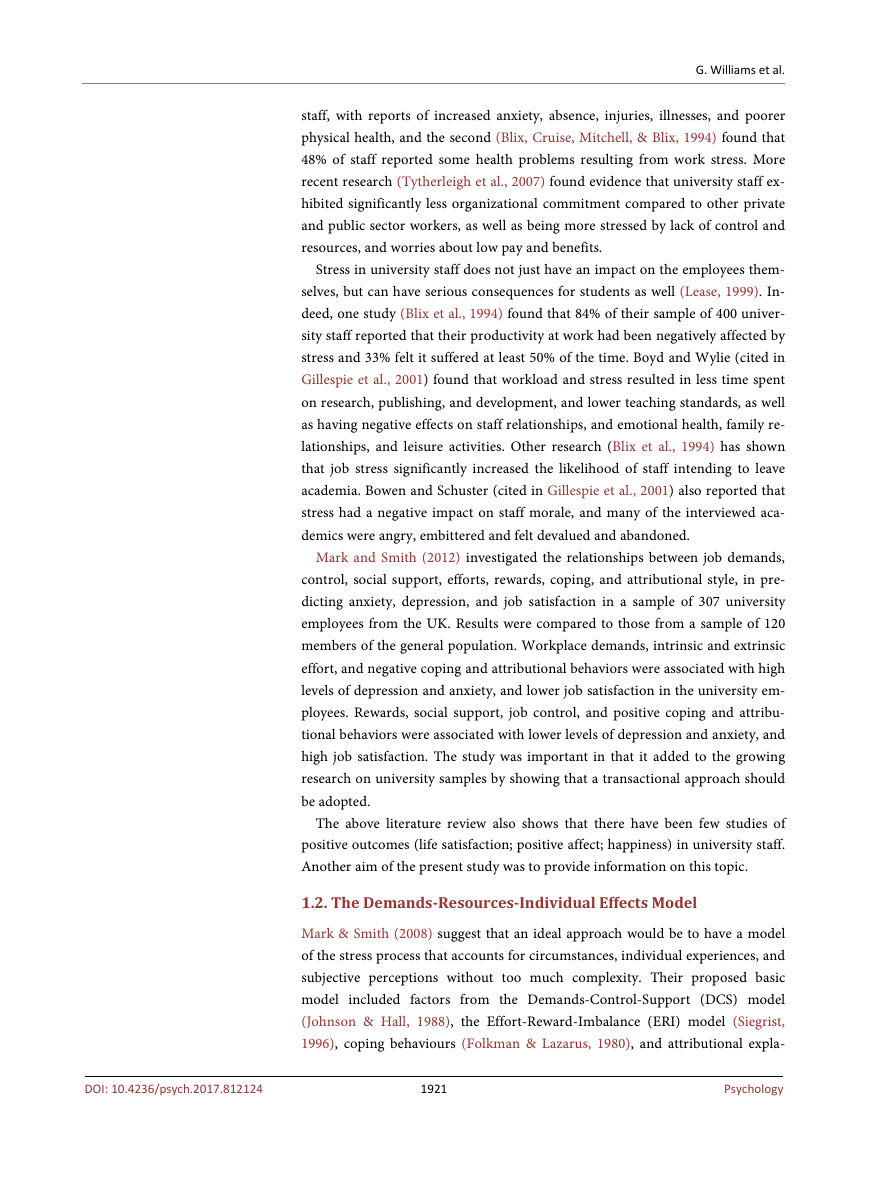
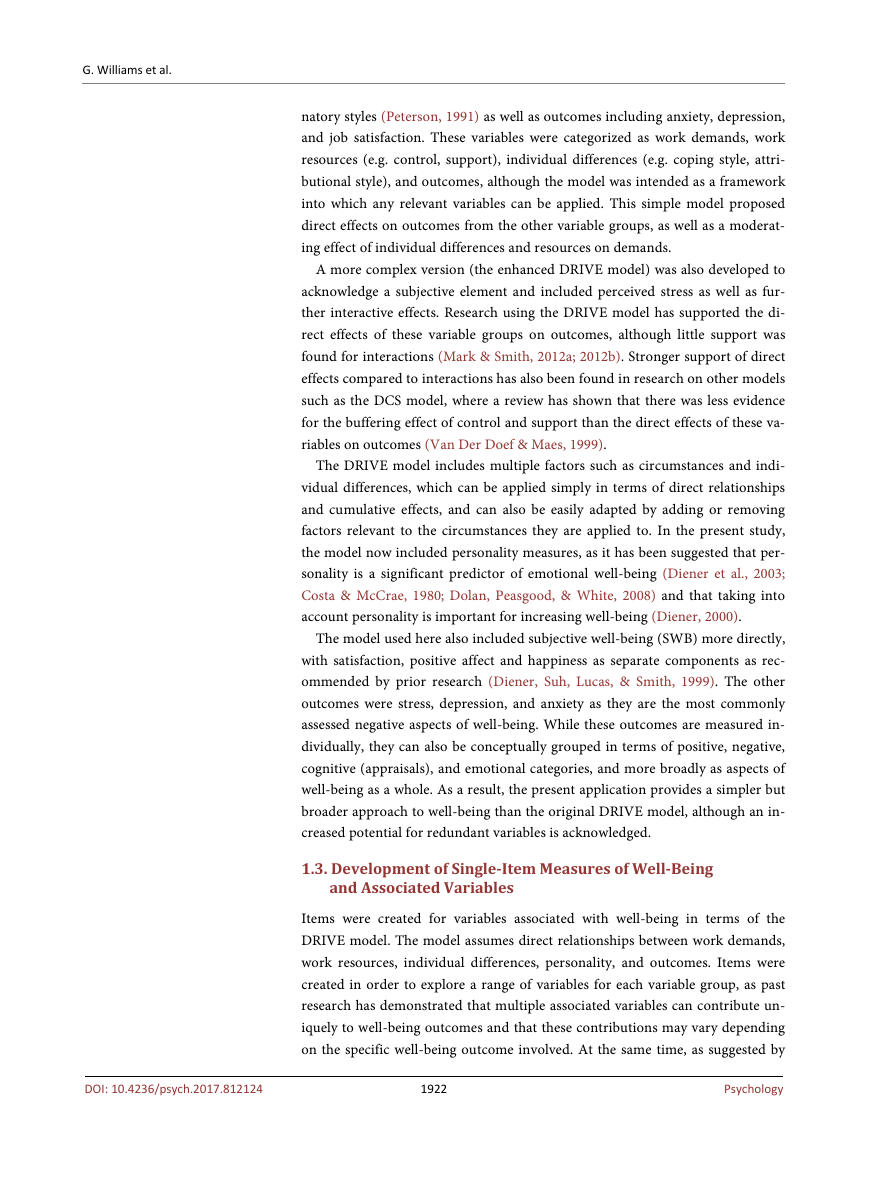
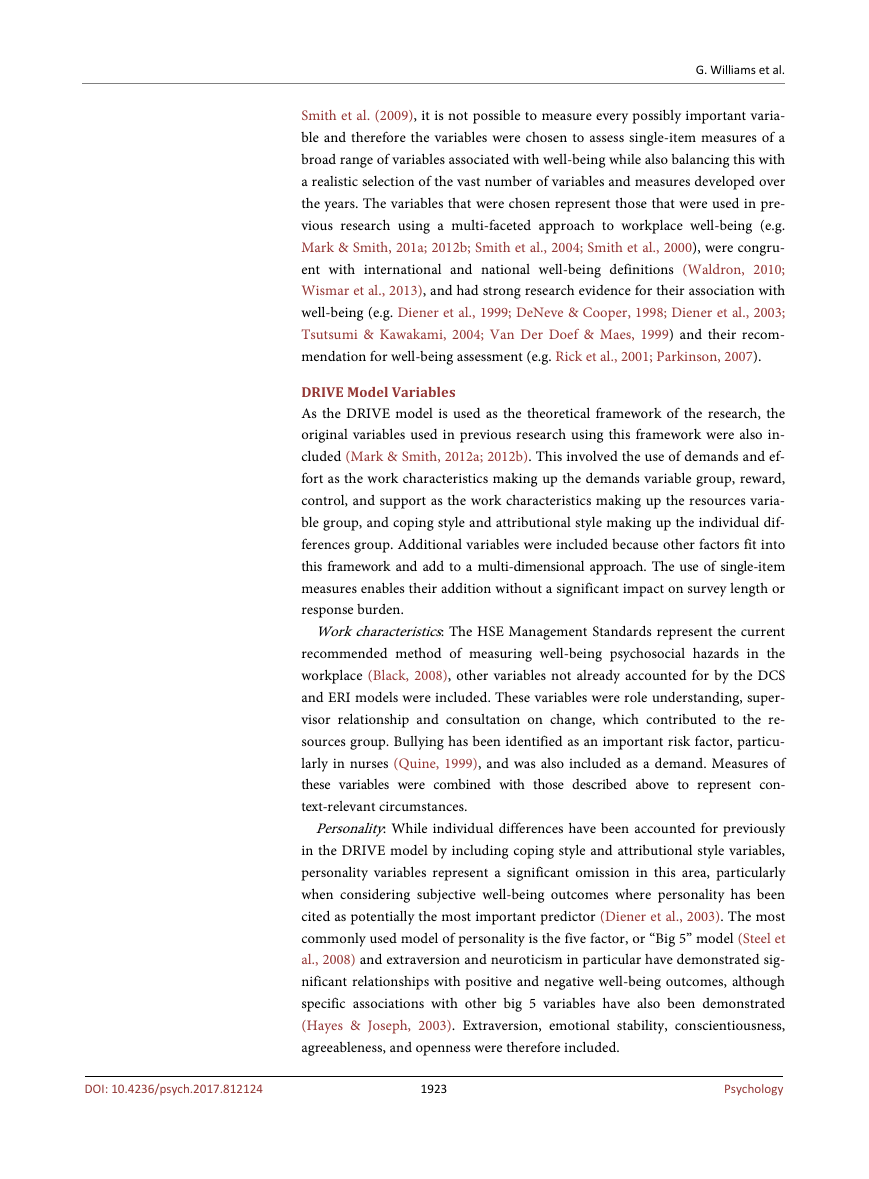
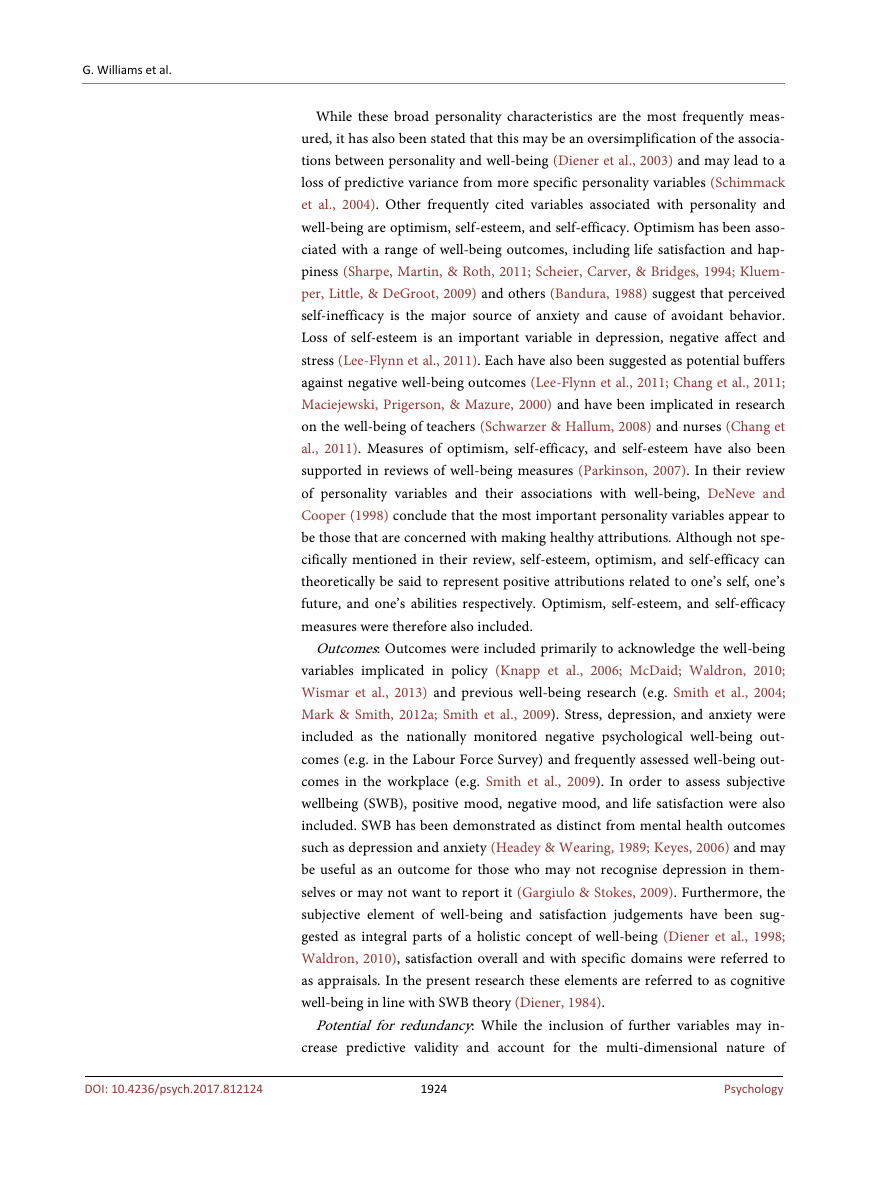
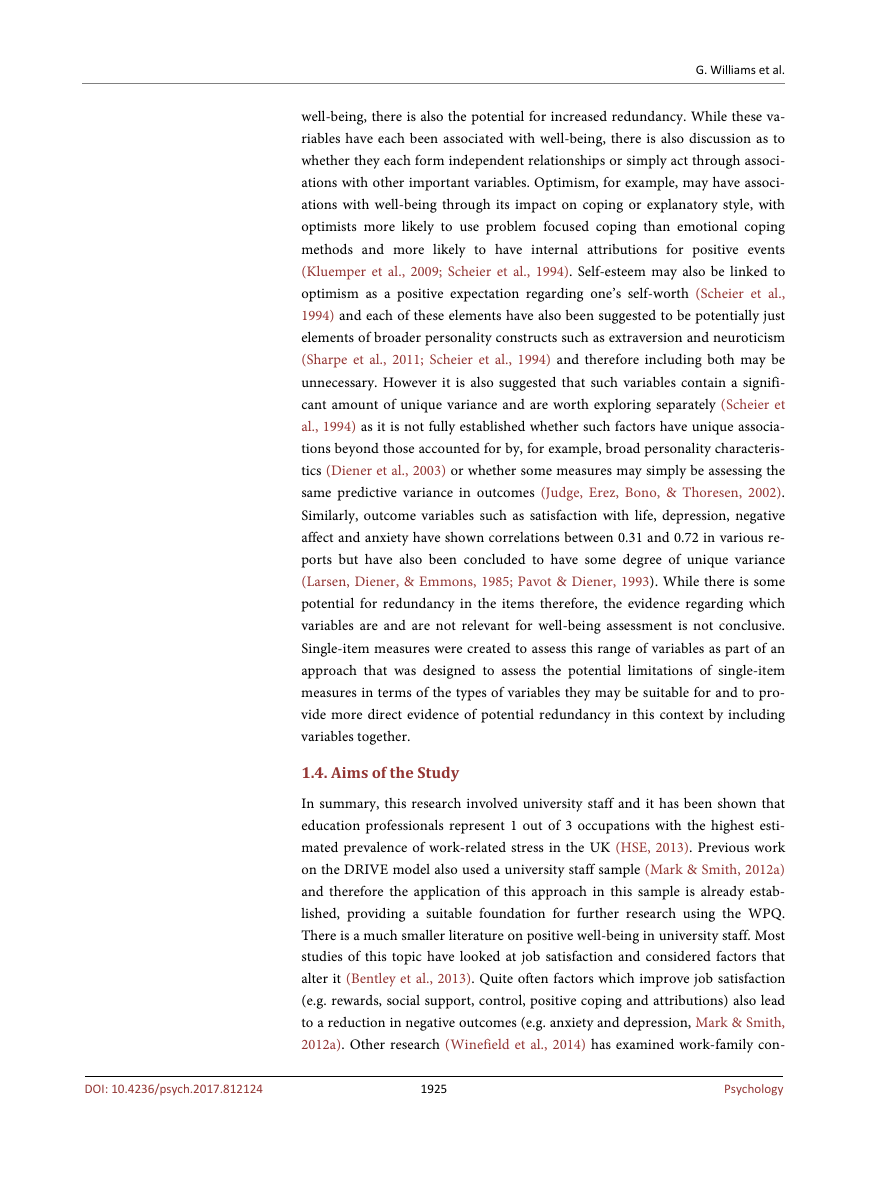









 2023年江西萍乡中考道德与法治真题及答案.doc
2023年江西萍乡中考道德与法治真题及答案.doc 2012年重庆南川中考生物真题及答案.doc
2012年重庆南川中考生物真题及答案.doc 2013年江西师范大学地理学综合及文艺理论基础考研真题.doc
2013年江西师范大学地理学综合及文艺理论基础考研真题.doc 2020年四川甘孜小升初语文真题及答案I卷.doc
2020年四川甘孜小升初语文真题及答案I卷.doc 2020年注册岩土工程师专业基础考试真题及答案.doc
2020年注册岩土工程师专业基础考试真题及答案.doc 2023-2024学年福建省厦门市九年级上学期数学月考试题及答案.doc
2023-2024学年福建省厦门市九年级上学期数学月考试题及答案.doc 2021-2022学年辽宁省沈阳市大东区九年级上学期语文期末试题及答案.doc
2021-2022学年辽宁省沈阳市大东区九年级上学期语文期末试题及答案.doc 2022-2023学年北京东城区初三第一学期物理期末试卷及答案.doc
2022-2023学年北京东城区初三第一学期物理期末试卷及答案.doc 2018上半年江西教师资格初中地理学科知识与教学能力真题及答案.doc
2018上半年江西教师资格初中地理学科知识与教学能力真题及答案.doc 2012年河北国家公务员申论考试真题及答案-省级.doc
2012年河北国家公务员申论考试真题及答案-省级.doc 2020-2021学年江苏省扬州市江都区邵樊片九年级上学期数学第一次质量检测试题及答案.doc
2020-2021学年江苏省扬州市江都区邵樊片九年级上学期数学第一次质量检测试题及答案.doc 2022下半年黑龙江教师资格证中学综合素质真题及答案.doc
2022下半年黑龙江教师资格证中学综合素质真题及答案.doc